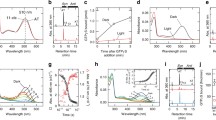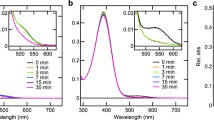Abstract
Bleached rhodopsin regenerates by way of the Schiff base formation between the 11-cis retinal and opsin. Recovery of human vision from light adapted states follows biphasic kinetics and each adaptive phase is assigned to two distinct classes of visual pigments in cones and rods, respectively, suggesting that the speed of Schiff base formation differs between iodopsin and rhodopsin. Matsumoto and Yoshizawa predicted the existence of a β-ionone ring-binding site in rhodopsin, which has been proven by structural studies. They postulated that rhodopsin regeneration starts with a non-covalent binding of the β-ionone ring moiety of 11-cis-retinal, followed by the Schiff base formation. Recent physiological investigation revealed that non-covalent occupation of the β-ionone ring binding site transiently activates the visual transduction cascade in the dark. In order to understand the role of non-covalent binding of 11-cis-retinal to opsin during regeneration, we studied the kinetics of rhodopsin regeneration from opsin and 11-cis-retinal and found that the Schiff base formation is accelerated ~107 times compared to that between retinal and free amine. According to Cordes and Jencks, Schiff base formation in solution exhibits a bell-shaped pH dependence. However, we discovered that the rhodopsin formation is independent of pH over a wide pH range, suggesting that aqueous solvents do not have access to the Schiff base milieu during its formation. According to Hecht et al. the regeneration of iodopsin must be significantly faster than that of rhodopsin. Does this suggest that the Schiff base formation in iodopsin is favored due to its structural architecture? The iodopsin structure once solved would answer such a question as how molecular fine-tuning of retinal proteins realizes their dark adaptive functions. In contrast, bacteriorhodopsin does not require occupancy of a distinct β-ionone ring-binding site, enabling an aldehyde without the cyclohexene ring to form a pigment. Studies of regeneration reaction of other retinal proteins, which are scarcely available, would clarify the molecular structure–phenotype relationships and their physiological roles.
Similar content being viewed by others
References
H. Matsumoto, T. Yoshizawa, Existence of a beta-ionone ring-binding site in the rhodopsin molecule, Nature, 1975, 258, 523–526.
E. H. Cordes, W. P. Jencks, On the Mechanism of Schiff Base Formation and Hydrolysis, J. Am. Chem. Soc., 1962, 84, 832–837.
S. Hecht, C. Haig, G. Wald, The Dark Adaptation of Retinal Fields of Different Size and Location, J. Gen. Physiol., 1935, 19, 321–337.
J. Nathans, D. Thomas, D. S. Hogness, Molecular genetics of human color vision: the genes encoding blue, green, and red pigments, Science, 1986, 232, 193–202.
T. Okano, D. Kojima, Y. Fukada, Y. Shichida, T. Yoshizawa, Primary structures of chicken cone visual pigments: vertebrate rhodopsins have evolved out of cone visual pigments, Proc. Natl. Acad. Sci. U. S. A., 1992, 89, 5932–5936.
D. Bownds, Site of attachment of retinal in rhodopsin, Nature, 1967, 216, 1178–1181.
R. Hubbard, G. Wald, Cis-trans isomers of vitamin A and retinene in the rhodopsin system, J. Gen. Physiol., 1952, 36, 269–315.
K. Palczewski, T. Kumasaka, T. Hori, C. A. Behnke, H. Motoshima, B. A. Fox, I. Le Trong, D. C. Teller, T. Okada, R. E. Stenkamp, et al. Crystal structure of rhodopsin: A G protein-coupled receptor, Science, 2000, 289, 739–745.
J. Li, P. C. Edwards, M. Burghammer, C. Villa, G. F. Schertler, Structure of bovine rhodopsin in a trigonal crystal form, J. Mol. Biol., 2004, 343, 1409–1438.
V. J. Kefalov, M. Carter Cornwall, R. K. Crouch, Occupancy of the chromophore binding site of opsin activates visual transduction in rod photoreceptors, J. Gen. Physiol., 1999, 113, 491–503.
V. J. Kefalov, R. K. Crouch, M. C. Cornwall, Role of noncovalent binding of 11-cis-retinal to opsin in dark adaptation of rod and cone photoreceptors, Neuron, 2001, 29, 749–755.
M. Audet, M. Bouvier, Restructuring G-protein- coupled receptor activation, Cell, 2012, 151, 14–23.
H. Matsumoto, T. Yoshizawa, Recognition of opsin to the longitudinal length of retinal isomers in the formation of rhodopsin, Vision. Res., 1978, 18, 607–609.
W. J. DeGrip, R. S. Liu, V. Ramamurthy, A. Asato, Rhodopsin analogues from highly hindered 7-cis isomers of retinal, Nature, 1976, 262, 416–418.
H. Matsumoto, R. S. H. Liu, C. J. Simmons, K. Seff, Longitudinal Restrictions of the Binding Site of Opsin As Measured with Retinal Isomers and Analogues, J. Am. Chem. Soc., 1980, 102, 4259–4262.
T. Okada, M. Sugihara, A. N. Bondar, M. Elstner, P. Entel, V. Buss, The retinal conformation and its environment in rhodopsin in light of a new 2.2 A crystal structure, J. Mol. Biol., 2004, 342, 571–583.
H. Nakamichi, V. Buss, T. Okada, Photoisomerization mechanism of rhodopsin and 9-cis-rhodopsin revealed by x-ray crystallography, Biophys. J., 2007, 92, L106–L108.
H. Nakamichi, T. Okada, Crystallographic analysis of primary visual photochemistry, Angew. Chem., Int. Ed., 2006, 45, 4270–4273.
H. W. Choe, Y. J. Kim, J. H. Park, T. Morizumi, E. F. Pai, N. Krauss, K. P. Hofmann, P. Scheerer, O. P. Ernst, Crystal structure of metarhodopsin II, Nature, 2011, 471, 651–655.
H. Matsumoto, K. Horiuchi, T. Yoshizawa, Effect of digitonin concentration on regeneration of cattle rhodopsin, Biochim. Biophys. Acta, 1978, 501, 257–268.
H. Matsumoto, T. Yoshizawa, Rhodopsin regeneration is accelerated via noncovalent 11-cis retinal-opsin complex–a role of retinal binding pocket of opsin, Photochem. Photobiol., 2008, 84, 985–989.
H. Matsumoto, Kinetic studies of rhodopsin regeneration (in Japanese), Kyoto University, 1977.
A. Cooper, S. F. Dixon, M. A. Nutley, J. L. Robb, Mechanism of retinal Schiff base formation and hydrolysis in relation to visual pigment photolysis and regeneration: resonance Raman spectroscopy of a tetrahedral carbinolamine intermediate and oxygen-18 labeling of retinal at the metarhodopsin stage in photoreceptor membranes, J. Am. Chem. Soc., 1987, 109, 7254–7263.
F. J. Daemen, The chomophore binding space of opsin, Nature, 1978, 276, 847–848.
R. K. Crouch, C. D. Veronee, M. E. Lacy, Inhibition of rhodopsin regeneration by cyclohexyl derivatives, Vision. Res., 1982, 22, 1451–1456.
G. Wald, P. K. Brown, P. H. Smith, Iodopsin, J. Gen. Physiol., 1955, 38, 623–681.
H. Imai, S. Kuwayama, A. Onishi, T. Morizumi, O. Chisaka, Y. Shichida, Molecular properties of rod and cone visual pigments from purified chicken cone pigments to mouse rhodopsin in situ, Photochem. Photobiol. Sci., 2005, 4, 667–674.
S. Kuwayama, H. Imai, T. Morizumi, Y. Shichida, Amino acid residues responsible for the meta-III decay rates in rod and cone visual pigments, Biochemistry, 2005, 44, 2208–2215.
A. Kropf, Is proton transfer the initial photochemical process in vision?, Nature, 1976, 264, 92–94.
R. Crouch, Y. S. Or, Opsin pigments formed with acyclic retinal analogues: Minimum ‘ring portion’ requirements for opsin pigment formation, FEBS Lett., 1983, 158, 139–142.
B.-. W. Zhang, A. Asato, M. Denny, T. Mirzadegan, A. Trehan, R. Liu, Isomers, visual pigment, and bacteriorhodopsin analogs of 3, 7, 13-trimethyl-10-isopropyl-2, 4, 6, 8, 10-tetradecapentaenal and 3, 7, 11-trimethyl-10-isopropyl-2, 4, 6, 8, 10-dodecapentaenal (two ring open retinal analogs), Bioorg. Chem., 1989, 17, 217–223.
A. E. Asato, B.-. W. Zhang, M. Denny, T. Mirzadegan, K. Seff, R. S. Liu, A study of the binding site requirements of rhodopsin using isomers of α-retinal and 5-substituted α-retinal analogs, Bioorg. Chem., 1989, 17, 410–421.
P. Towner, W. Gaertner, B. Walckhoff, D. Oesterhelt, H. Hopf, Regeneration of rhodopsin and bacteriorhodopsin. The role of retinal analogues as inhibitors, Eur. J. Biochem., 1981, 117, 353–359.
G. S. Harbison, S. O. Smith, J. A. Pardoen, J. M. Courtin, J. Lugtenburg, J. Herzfeld, R. A. Mathies, R. G. Griffin, Solid-state carbon-13 NMR detection of a perturbed 6-s-trans chromophore in bacteriorhodopsin, Biochemistry, 1985, 24, 6955–6962.
B. Isralewitz, S. Izrailev, K. Schulten, Binding Pathway of Retinal to Bacterio-Opsin: A Prediction by Molecular Dynamics Simulations, Biophys. J., 1997, 73, 2972–2979.
A. Warshel, Bicycle-pedal model for the first step in the vision process, Nature, 1976, 260, 679–683.
R. S. Liu, A. E. Asato, The primary process of vision and the structure of bathorhodopsin: a mechanism for photoisomerization of polyenes, Proc. Natl. Acad. Sci. U. S. A., 1985, 82, 259–263.
R. W. Schoenlein, L. A. Peteanu, R. A. Mathies, C. V. Shank, The first step in vision: femtosecond isomerization of rhodopsin, Science, 1991, 254, 412–415.
J. Herbst, K. Heyne, R. Diller, Femtosecond infrared spectroscopy of bacteriorhodopsin chromophore isomerization, Science, 2002, 297, 822–825.
S. L. Logunov, L. Song, M. A. El-Sayed, Excited-state dynamics of a protonated retinal Schiff base in solution, J. Phys. Chem., 1996, 100, 18586–18591.
H. Kandori, Y. Katsura, M. Ito, H. Sasabe, Femtosecond Fluorescence Study of the Rhodopsin Chromophore in Solution, J. Am. Chem. Soc., 1995, 117, 2669–2670.
H. Nakamichi, T. Okada, Local peptide movement in the photoreaction intermediate of rhodopsin, Proc. Natl. Acad. Sci. U. S. A., 2006, 103, 12729–12734.
G. Steinberg, M. Ottolenghi, M. Sheves, pKa of the protonated Schiff base of bovine rhodopsin. A study with artificial pigments, Biophys. J., 1993, 64, 1499–1502.
J. Liang, G. Steinberg, N. Livnah, M. Sheves, T. G. Ebrey, M. Tsuda, The pKa of the protonated Schiff bases of gecko cone and octopus visual pigments, Biophys. J., 1994, 67, 848–854.
H. Matsumoto, F. Tokunaga, T. Yoshizawa, Accessibility of the iodopsin chromophore, Biochim. Biophys. Acta, 1975, 404, 300–308.
F. Crescitelli, The gecko visual pigment: the dark exchange of chromophore, Vision Res., 1984, 24, 1551–1553.
Y. Shichida, T. Kato, S. Sasayama, Y. Fukada, T. Yoshizawa, Effects of chloride on chicken iodopsin and the chromophore transfer reactions from iodopsin to scotopsin and B-photopsin, Biochemistry, 1990, 29, 5843–5848.
V. J. Kefalov, M. E. Estevez, M. Kono, P. W. Goletz, R. K. Crouch, M. C. Cornwall, K. W. Yau, Breaking the covalent bond–a pigment property that contributes to desensitization in cones, Neuron, 2005, 46, 879–890.
T. Isayama, Y. Chen, M. Kono, W. Degrip, J.-. X. Ma, R. Crouch, C. Makino, Differences in the pharmacological activation of visual opsins, Vis. Neurosci., 2006, 23, 899–908.
D. Corson, M. Cornwall, E. MacNichol, V. Mani, R. Crouch, Transduction noise induced by 4-hydroxy retinals in rod photoreceptors, Biophys. J., 1990, 57, 109.
Author information
Authors and Affiliations
Corresponding author
Additional information
This manuscript is submitted as a contribution to the special issue dedicated to the 16th International Conference on Retinal Proteins held in Nagahama, Japan, on October 5-10, 2014.
Rights and permissions
About this article
Cite this article
Matsumoto, H., Iwasa, T. & Yoshizawa, T. The role of the non-covalent β-ionone-ring binding site in rhodopsin: historical and physiological perspective. Photochem Photobiol Sci 14, 1932–1940 (2015). https://doi.org/10.1039/c5pp00158g
Received:
Accepted:
Published:
Issue Date:
DOI: https://doi.org/10.1039/c5pp00158g




